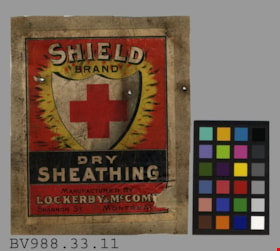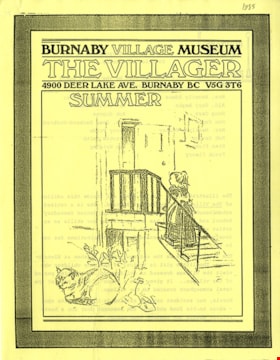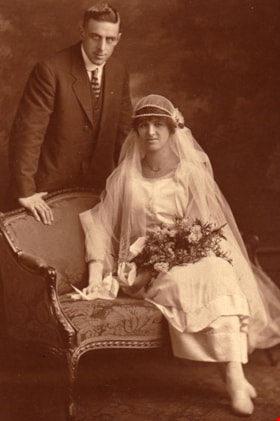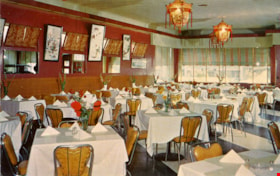Narrow Results By
Subject
- Agriculture - Farms 1
- Building Components 1
- Buildings - Commercial - Grocery Stores 2
- Buildings - Commercial - Restaurants 1
- Buildings - Heritage 3
- Buildings - Industrial - Mills 2
- Buildings - Industrial - Saw Mills 1
- Buildings - Industrial - Sawmills 1
- Buildings - Residential - Houses 4
- Clothing 1
- Communication Artifacts 1
- Construction - Road Construction 1
Person / Organization
- A & H Plastering and Stucco 1
- Ansdell, Elsie Brown-John 4
- Bayntun, Charmaine "Sherrie" Yanko 1
- Bell, Flora 1
- Bell's Dry Goods 1
- Bell, William 1
- Bingham, Alfred "Alf" 26
- Bradbury, Dr. Bettina 14
- Brown-John, Victor Joseph Charles 1
- Brown-John, Winnifred Douglas 2
- Burnaby South High School 2
- Burnaby Village Museum 2
Jesse Love farmhouse series
https://search.heritageburnaby.ca/link/museumdescription9782
- Repository
- Burnaby Village Museum
- Date
- [1893-1970] (date of originals), copied 1988-1998, predominant 1988-2000
- Collection/Fonds
- Burnaby Village Museum fonds
- Description Level
- Series
- Physical Description
- approx. 84 cm of textual records + approx. 1,910 photographs + approx. 100 architectural drawings + 3 audio cassettes + 1 videocassette
- Scope and Content
- Series consists of records involved in the purchase, moving, restoration, research, conservation and exhibiting of the Love family farmhouse by Burnaby Village Museum. Records have been arranged into the following subseries: 1) Love farmhouse conservation work files subseries 2) Love farmhouse re…
- Repository
- Burnaby Village Museum
- Collection/Fonds
- Burnaby Village Museum fonds
- Series
- Jesse Love farmhouse series
- Description Level
- Series
- Physical Description
- approx. 84 cm of textual records + approx. 1,910 photographs + approx. 100 architectural drawings + 3 audio cassettes + 1 videocassette
- Scope and Content
- Series consists of records involved in the purchase, moving, restoration, research, conservation and exhibiting of the Love family farmhouse by Burnaby Village Museum. Records have been arranged into the following subseries: 1) Love farmhouse conservation work files subseries 2) Love farmhouse restoration photographs subseries 3) Love farmhouse curatorial files subseries 4) Love farmouse research files subseries 5) Love family photographs 6) Love farmhouse Oral History subseries 7) Love farmhouse architectural drawings subseries
- History
- Jesse Love was born in Swindon, England in 1847 and left England to work on a dairy farm in the Toronto area. While working on the farm in Toronto, he met Martha Leonard who he married in 1879. Martha was born on February 3, 1858 in Bedfordshire, England and had come to Canada with her parents George and Ann Leonard. While living in Toronto, Jesse and Martha had two children, George born March 22, 1880 and Annie Elizabeth on August 24, 1881. About one year after Annie was born, the Love family moved to North Dakota to grow wheat. While living there, they had two more children, Henry who was born August 24, 1883 and Edith Minnie born October 9, 1885. The family decided to move further west after hearing about the fairer weather conditions from Martha’s father, George Leonard, who had settled in Vancouver in 1885. On May 23, 1887, Jesse, Martha and their four children arrived in Vancouver after travelling across Canada from Winnipeg on the first transcontinental train. The Loves made their home in Vancouver while Jesse helped clear land on Granville Street. Their fifth child, Thomas Robert was born on September 17, 1887 and soon after, the family moved to Lulu Island in Richmond where they lived growing vegetables and selling them to Vancouver hotels. While living and farming on Lulu island, the couple had two more girls, Martha (Dot or Dorothy) born on December 17, 1889 and Sarah Marie, born February 8, 1892. On October 6, 1893 an agreement was signed by Jesse Love to purchase 14.52 acres of land from Joseph C. Armstrong. The acreage covered the north east section of District Lot 25 within the newly incorporated District of the Municipality of Burnaby. It was here where the original Love house was built (between October 1893 and April 15, 1894) by Jesse Love with the help of local builder George Salt and father in law, George Leonard. The house consisted of an entrance hall, dining room, lean to kitchen, master bedroom and three bedrooms upstairs. A road was constructed and named Cumberland in 1905 and ran from District Lot 25 through to District Lot 11. The address for the Love home was 1390 Cumberland Road and in the early 1960’s the address was renumbered 7651 Cumberland Street. On the land surrounding the house, Jesse Love planted an orchard along with strawberries and raspberries which he sold at the Fraser Valley Market, T.S. Anandale’s Grocery Store in New Westminster and to hotels around Vancouver. Jesse Love served on the Burnaby School Board and also as a District Councillor in 1901 and from 1904-1907. While living in the house, Jesse and Martha had four more children, Phoebe Leonard, born April 15, 1894, Esther, born August 28, 1896, John Leonard, born June 7, 1899 and Hannah Victoria (also known as Girlie) who was born May 12, 1902. As the family grew to eleven children, additions along with some substantial remodelling in the craftsman style took place. In about 1898, a north wing addition was added to include a parlour with two windows, the construction of two more bedrooms and the relocation of the stair case to the North West wall. In 1903 the front door moved to the north elevation, a front porch was extended along the east wall and a summer lean to kitchen was added to the west elevation. Between 1905 and 1910, a tin embossed ceiling was installed along with an addition of the main kitchen which included a pantry, bathtub and a back porch. In about 1912, five craftsman style windows replaced the original pioneer tent style, the front verandah was enlarged to wrap around the south and east elevations, a back door was installed in the kitchen to access the verandah and wood shingle siding and brackets were added to the exterior. In 1918, at the age of 31 years, Robert Love fell ill due to an influenza epidemic and died on November 23, 1918. Following their son’s death, Martha Love became weak and on August 24, 1920, she passed away. By this time, Jesse had sold off a large percentage of his land and his youngest daughter, Girlie decided to stay on to live and care for him. Since the house was too large for just the two of them, Jesse invited any other children to return and share the residence. For a while his son, George and his wife joined them until 1925, followed by his daughter Sarah Parker (nee Love), her husband William and their three children, Albert, Bill and Elsie. The house remained pretty unchanged until 1928 after Jesse Love died of pneumonia (March 10, 1928) and the house was purchased by Sarah and her husband William Parker who continued to live there with their children. The master bedroom wall on the main floor opened up to the dining room, the kitchen pantry and bathtub converted to an alcove with a marble counter and enlarged window and sink while the bathroom was moved to the upstairs and the furnace and coolers were installed in the crawl space under the kitchen. A hot water tank was installed in the house in 1966. Sarah continued to live in the house until a little while after her husband William died in 1961. She sold the house to her daughter Elsie and husband John Hughes in 1966, who lived in the house along with their son Brent, until August 23, 1971. Mahbir Molchan Papan and his wife Geraldine Papan bought the house August 23, 1971 and by 1982, the house was sold to Nirmal Singh Singha and Narinder Singha. The Papans continued to rent the house from Nirmal Singh Singha and Narinder Singha until the late 1980s. In 1988, the house was scheduled for demolition with the remaining property to be subdivided. Fortunately, a neighbour, Mr. Harvey Elder recognized the farmhouse's historical significance and contacted the Burnaby Historical Society. Following this event, the owners agreed to donate the building to the Burnaby Village Museum (under the Century Park Museum Association) who financed the move of the house from Cumberland Street to the museum site. Heritage planner and architect, Robert Lemon provided guidance for the project. Prior to the move, the two porches were removed and demolished while the kitchen and roof were both separated from the main house. The kitchen and roof of the house were transported to Burnaby Village Museum on May 20, 1988 by Nickel Bros. House Moving company, while the main frame of the house completed its transportation to the museum near the end of May 1988 (due to low overhead wires). The house was moved down Cumberland Street to 10th Avenue, up Canada Way to Sperling and set on temporary footings near Hart House. Robert Lemon oversaw structural improvements such as, upgrading floor joists and creating new foundations to replace the original timber foundation of the farmhouse. The restoration went through several phases of work between 1988 until it opened in November 1998. Restoration began on both the interior and exterior features to be interpreted from the period of 1925. On November 23, 1992, the building was designated a heritage building under Heritage Designation Bylaw 1992, Bylaw Number 9807. In 1993, the architecture firm of Brian G. Hart Associates was appointed for the design and construction supervision of the restoration project. Plans were created for a foundation on the museum site in 1989 and the farmhouse was eventually settled on a permanent foundation behind the Burnaby Village Museum administration building in 1993 along with the reattachment of the roof. The kitchen section was reattached to the main house in 1994 along with skirting around the foundation and the reshingling of the exterior. In 1996, the tin ceiling was removed to make way for the installation of the internal electrical system along with sprinklers, ceiling heating and fire break gyprock. The dining room ceiling joists were consolidated, a pantry and bathroom were added to the kitchen, the downstairs bedroom wall was opened and filled, the dining and kitchen doorways were widened. In 1997, a wheelchair ramp was installed along with a concrete sidewalk, stair rails, cement pads at the base of the stairs and a gravel sink for any excess water. Interior work included painting of the kitchen, restoration and furnishing of the kitchen pantry, insulation of the house floor to protect from rodents along with the reconstruction of the kitchen and house chimneys. The registrar worked together with the curator and conservator and was tasked with a large research project on the house including the family contacts and family history, property information, plans, photographs, artifacts, furnishings, stories etc. all organized in files for easy retrieval. A great deal of research and conservation was undertaken in order to make the interior of the house authentic to the time period as possible. One of the biggest projects was selecting and obtaining wall coverings since much of the original wallpaper was incomplete and poor condition. The conservator and registrar were lucky enough to locate a few samples of the original paper and engage the Bradbury and Bradbury Art Wallpaper Company of Benica, California to reproduce replica designs for free. The City of Burnaby now has its own series “Burnaby Village Papers” produced by this company which are titled “Burnaby Wall”; “Burnaby Border” and “Burnaby Ceiling”. All three of these wallpaper designs have been used in the Love farm house and are also commercially available through the Bradbury and Bradbury Art Wallpaper Company. In 1997, restoration of the kitchen was completed and opened to the public. After the completion of the dining room, main floor bedroom and parlour, the Love farmhouse exhibit opened on November 29, 1998 with an open invitation to the public and extended members of the Love family. Officials including the Mayor, Doug Drummond and Love family members were all present to cut the ribbon for the special event.
- Accession Code
- BV018.41; BV020.5
- Access Restriction
- Restricted access
- Date
- [1893-1970] (date of originals), copied 1988-1998, predominant 1988-2000
- Arrangement
- The majority of the records within series and subseries were arranged by a staff members of Burnaby Village Museum who worked on the historical research and restoration of the house. Other photographs documenting the move and further restoration work were added later and included in the arrangment by format and subject.
- Notes
- Title based on content of series
- Jesse Love farmhouse is described as an Artifact under BV988.33.1
- Some records within this collection have restricted access and are subject to FIPPA
- Accessions BV018.41 and BV020.5 form this fonds
skis
https://search.heritageburnaby.ca/link/museumartifact36910
- Repository
- Burnaby Village Museum
- Accession Code
- BV988.33.22
- Description
- Home made skis made by William Parker. The original leather bindings are mostly gone, only one broken, dark coloured leather strap remains.
- Object History
- The skis were found in the Jesse Love farmhouse when moved to the Museum. The skis were hand made by Bill Parker, grandson of Jesse Love and son of Sarah Parker (Love) and William Parker. He made them while living in the Love farmhouse as a young man. He often did woodworking in the kitchen, after the bath tub was moved upstairs and before the kitchen was remodeled. When he was older his woodwork projects were done in the wood working shed outside. The skis were originally flat, but he found they did not work well. After observing people on store bought skis, he tried to steam the wood and weigh down the ends to get the tips of the skis to curve. He use the skis to around the yard and down the hill of Cumberland St. Bill later used the skis as a young adult while courting his wife. The skis were stored in the house and forgotten.
- A pair of skis in one corner of the farmhouse kitchen are visible in photographs of the kitchen taken in the early 1970.
- Maker
- Bill Parker
- Country Made
- Canada
- Province Made
- British Columbia
- Site/City Made
- Jesse Love Farmhouse
- Subjects
- Recreational Activities
- Geographic Access
- Cumberland Street
- Historic Neighbourhood
- East Burnaby (Historic Neighbourhood)
Images
Interview with Margaret Jane (Jean) Wright 1992 - Track 6
https://search.heritageburnaby.ca/link/museumdescription4640
- Repository
- Burnaby Village Museum
- Date
- July 8 1992
- Collection/Fonds
- Burnaby Village Museum Oral History collection
- Description Level
- Item
- Physical Description
- 1 audio cassette (0:22:04 min)
- Scope and Content
- Track 6: This portion of the recording pertains to the way life has changed since Jean was a child. Jean describes how chores were done, and how supplies were delivered. She and Terry discuss the amenities in the family’s houses, how mail was picked up, and how telephone messages were received and …
- Repository
- Burnaby Village Museum
- Collection/Fonds
- Burnaby Village Museum Oral History collection
- Description Level
- Item
- Physical Description
- 1 audio cassette (0:22:04 min)
- Material Details
- Interviewer: Teresa Ballentine Interviewee: Margaret Jane (Jean) Wright (later Jean McCallum and later Jean Hogg) Date of interview: July 8, 1992 Total Number of Tracks: 6 Total Length of all Tracks: 1:09:29
- Scope and Content
- Track 6: This portion of the recording pertains to the way life has changed since Jean was a child. Jean describes how chores were done, and how supplies were delivered. She and Terry discuss the amenities in the family’s houses, how mail was picked up, and how telephone messages were received and relayed. Terry shares a memory of her grandmother Wright. Jean recalls the house on Kitchener Street which she and Walter built. She and Terry talk about the MacLure bus service. Terry recalls Jean’s kindness to neighbors, and how they reciprocated. Jean shares her perspective about the friendliness and sharing among neighbors which were usual at that time. She describes the work involved in clearing the lot and building the house on Kitchener Street, and how she kept a kitchen garden and domestic animals there. Jean discusses how hair styling was done in her youth, and relates a story of how her mother had a poor result with colouring products. She mentions her father using a razor and strop, and how the strop was also a symbol of physical punishment, common at that time. She describes a punishment she received in school. Jean recalls making treats, and talks about push lawnmowers, wooden sidewalks, and gravel roads. She and Terry talk about the family’s pianos and their importance to the family. Jean recalls the piano teachers her family members took lessons from and Terry remarks that the last one, Edward Parker, is the father of Jon Kimura Parker, a noted pianist.
- History
- Recording is an interview with Jean Hogg conducted by her daughter Teresa Ballentine. Jean talks about her life as a resident of Burnaby from her childhood in the 1910s to widowhood in the 1960s. Margaret Jane (Jean) Wright was born in Burnaby in August 1915, two years after her family moved to 3871 East Pender Street. She was one of five children of Joseph Wright and Wilhelmina Williams. Her first husband was Walter Angus McCallum, who she was married to from 1940-1965; they raised two daughters: June and Teresa. Her second husband's last name was Hogg.
- Creator
- Ballentine, Teresa
- Accession Code
- BV018.17.1
- Access Restriction
- No restrictions
- Date
- July 8 1992
- Media Type
- Sound Recording
- Notes
- Title based on content of sound recording
- Label on audio cassette case reads: "Jean & Terry / Re / Jeans Memories & / Her Life History"
- Label on Side A of audio cassette reads: "Jean Hogg - Memories / 1"
- Label on Side B of audio cassette reads: "Jean Hogg Memories / 2"
Audio Tracks
Interview with Margaret Jane (Jean) Wright 1992 - Track 6, July 8 1992
Interview with Margaret Jane (Jean) Wright 1992 - Track 6, July 8 1992
https://search.heritageburnaby.ca/media/hpo/_Data/_BVM_Sound_Recordings/Oral_Histories/2018_0017_0001_006.mp3Oral history interview with Albert Parker - May 9, 1988 - Track 6
https://search.heritageburnaby.ca/link/museumdescription10397
- Repository
- Burnaby Village Museum
- Date
- [between 1925 and 1930] (interview content), interviewed May 9 1988
- Collection/Fonds
- Burnaby Village Museum fonds
- Description Level
- Item
- Physical Description
- 1 audio cassette (0:11:00 min) + 2 p. of textual records
- Scope and Content
- Track 6: This portion of the recording pertains to the kitchen and the kitchen bathroom of the Love family farmhouse. Albert describes the furnishings and layout, and the changes he remembers.
- Repository
- Burnaby Village Museum
- Collection/Fonds
- Burnaby Village Museum fonds
- Series
- Jesse Love farmhouse series
- Description Level
- Item
- Physical Description
- 1 audio cassette (0:11:00 min) + 2 p. of textual records
- Material Details
- Interviewer: Jim Wolf Interviewee: Albert Parker Location of Interview: Love Farmhouse, Burnaby Interview Date: May 9, 1988 Total Number of Tracks: 8 Total Length of all Tracks: 1:11:15
- Scope and Content
- Track 6: This portion of the recording pertains to the kitchen and the kitchen bathroom of the Love family farmhouse. Albert describes the furnishings and layout, and the changes he remembers.
- History
- Recording is an interview with Albert Parker about the Love family house, which was his family’s home and which has been relocated to the Burnaby Village Museum site as an exhibit. He also briefly discusses his parents, William Parker and Sarah Love Parker, his siblings William and Elsie, and his grandfather Jesse Love.
- Creator
- Wolf, Jim
- Accession Code
- BV018.41.48
- Access Restriction
- No restrictions
- Reproduction Restriction
- May be restricted by third party rights
- Date
- [between 1925 and 1930] (interview content), interviewed May 9 1988
- Media Type
- Sound Recording
- Notes
- Title based on content of file
- 1 copy of audio cassette accompanying along with interview notes
Images
Audio Tracks
Oral history interview with Albert Parker - May 9, 1988 - Track 6, [between 1925 and 1930] (interview content), interviewed May 9 1988
Oral history interview with Albert Parker - May 9, 1988 - Track 6, [between 1925 and 1930] (interview content), interviewed May 9 1988
https://search.heritageburnaby.ca/media/hpo/_Data/_BVM_Sound_Recordings/Oral_Histories/2018_0041_0048_006.mp3Barbie clothes and accessories.
https://search.heritageburnaby.ca/link/museumartifact82623
- Repository
- Burnaby Village Museum
- Accession Code
- BV012.14.159
- Description
- Handmade Barbie clothes and various accessories. Large box contains: a)tray containing various Barbie clothes on hangers b)tray containing various Barbie clothes on hangers c)tray containing various Barbie clothes and wigs on plastic stand d)plastic box containing various Barbie pants and skirts e)plastic box containing various Barbie accessories and baby doll f)plastic box containing various Barbie accessories, including metal tin containing shoes and paper box g)blue floral pattern tin containing Barbie kitchen accessories h)green floral pattern tin containing two small pillows
- Object History
- From the Yanko family home in Burnaby. Barbie clothes made by Lillian Yanko, mother. Barbies belonged to daughters Charmaine and Rhonda Yanko. Annie D. Basiuk (later Yanko) was born on February 25, 1902 in Sheho, Saskatchewan (formerly Sheho, North West Territories). Daniel "Dan" Yanko was born in Kobilnicha, Ukraine in 1887 and immigrated to Canada in May or June of 1905. Daniel Yanko married Annie D. Basiuk and had thirteen children together. Their son, John Ivan Yanko was born on the family farm, near Kelliher, Saskatchewan, on June 27, 1923. In grade six, John was pulled out of school to help support the family. Eugenia “Jenny” Haresomovych (later Carman) was born August 8, 1904 in Galecia, Austria. She came to Canada in 1928, when her parents sent her to live with the Austrian consular in Halifax. A year later, she was in The Pas with Albert Edward Carman, with whom she would have three children. Their daughter, Leida Doria "Lillian Doris" Carman was born in The Pas, Manitoba March 24, 1929. Eugenia “Jenny” (Haresomovych) Carman later re-married Joseph Nagy who was born in Hungary in October 3, 1900. Jenny, Joseph and the children moved to Nelson, British Columbia, where Joseph worked for the Canadian Pacific Railway. At the age of twenty, John Yanko met his future wife Lillian Doris Carman while visiting relatives in Burnaby. Lillian received a rail pass because of her dad’s employment with the CPR and at fourteen had gone to visit her Godmother in Burnaby. John Ivan Yanko and Leida Doria "Lillian Doris" Carman were married October 16, 1948 in Nelson, British Columbia and moved into the basement of John’s sister’s house on Union Street. Lillian began working at the downtown Woodward’s store as a cashier in 1948. In 1950, the young couple bought property at 7385 (later renumbered 7391) Broadway in Burnaby and began constructing a house as they could afford it. Knowing she’d be let go if she was pregnant, when Lillian was expecting her first child, Jenny sewed her several versions of the same outfit; they all used the same material, but each was a little bit larger than the last to accommodate her expanding girth. Rhonda, born in 1953 and Charmaine, born in 1955, grew up in the Broadway home. They attended school at Sperling Elementary, and later at Burnaby North high school. Lillian left her job to be a stay-at-home mom when Rhonda was born, but that changed in 1963 when John and Charmaine were in a car accident that left John temporarily unable to work. Joseph Nagy died April 20, 1962; his wife Eugenia “Jenny” (Haresomovych) (Carman) Nagy passed away August 14, 1985. Daniel "Dan" Yanko died in 1976; his wife Annie D. (Basiuk) Yanko died in 1997. John Yanko later returned to work, establishing his own tile setting business and working until age eighty-two. John and Lillian lived out the rest of their married lives on the Broadway property. John Ivan Yanko passed away in 2010; his wife Leida Doria "Lillian Doris" Carman (Carman) Yanko passed away in 2011.
- Subjects
- Toys
- Names
- Yanko Family
- Bayntun, Charmaine "Sherrie" Yanko
- Yanko, Leida Doria "Lillian Doris" Carman
- Yanko, Rhonda
Images
booklet
https://search.heritageburnaby.ca/link/museumartifact19382
- Repository
- Burnaby Village Museum
- Accession Code
- HV977.37.34
- Description
- Helpful Hints for Housekeepers - Pamphlet -- [1915]. Small booklet produced by The Dodds Medicine Company Ltd, which is volume 5 of the Helpful Hints for Housekeepers. The booklet provides household information about kitchen rearranging and health remedies using common household products. On the back side of the cover are advertisements for The Dodds Medicine products.
- Object History
- From the family home of Thomas Seaborn McNair and Mary Vida (nee McMillan) McNair who lived on West 33rd Avenue in Vancouver. Thomas McNair ran Edwards, McNair and Russell, an established estate agent business.
Images
booklet
https://search.heritageburnaby.ca/link/museumartifact30042
- Repository
- Burnaby Village Museum
- Accession Code
- HV973.76.8
- Description
- Rawleigh's Good Health Guide 40th Anniversary - Booklet -- [1929]. Rawleigh's 40th Anniversary Good Health Guide and Cook Book. The cover is mainly black with a coloured picture of a woman and a girl backing in the kitchen. Written below the picture is "HER FIRST LESSON". There is a hole in the top left corner for hanging. The back cover has a coloured picture of a woman and dog on steps, and boy carrying suitcase and man behind him. There is a Rawleigh's truck parked on road in the background. Written below the picture is "HERE'S THE RAWLEIGH MAN AGAIN MOTHER". There is white space below for stamp which was left blank. "Printed in Canada"; 1929 edition
- Country Made
- Canada
- Province Made
- Ontario
- Site/City Made
- London
- Title
- The Rawleigh's 40th Anniversary Good Health Guide and Cook Book
- Publication Date
- 1929
Images
booklet
https://search.heritageburnaby.ca/link/museumartifact46815
- Repository
- Burnaby Village Museum
- Accession Code
- BV985.6116.1
- Description
- Helpful Hints for Housekeepers - Pamphlet -- [1924]. Small booklet produced by The Dodds Medicine Company Ltd, which is volume XIV of the Helpful Hints for Housekeepers. The booklet provides household information about kitchen rearranging and health remedies using common household products along with information on the Dodds Medicine products. On the back side of the cover are advertisements for The Dodds Medicine products.
- Marks/Labels
- Helpful Hints for Housekeepers Compliments of the Dodds Medicine Co. Limited
- Title
- Helpful Hints for Housekeepers
Images
building
https://search.heritageburnaby.ca/link/museumartifact3846
- Repository
- Burnaby Village Museum
- Accession Code
- BV988.33.1
- Description
- The core of the Jessie Love farm house is a 1893 two story, pioneer tent style building. The home was added to over the years and became a large Craftsmen style farm house.
- Object History
- Built on Cumberland Road in Burnaby in 1893. Music Room/Parlour/Living Room and bedrooms above added c.1898. Kitchen added c.1908. The home of Jesse and Martha Love and their eleven children. One of Burnaby's oldest structures. The home was moved to Burnaby Village Museum in the late 1980s and has been partially restored to its 1920s appearance.
- Category
- 01. Built Environment Objects
- Classification
- Structures - - Dwellings
- Object Term
- House
- Colour
- Brown
- Culture
- Canadian
- Geographic Access
- Cumberland Street
- Street Address
- 6501 Deer Lake Avenue
- Historic Neighbourhood
- East Burnaby (Historic Neighbourhood)
- Planning Study Area
- Cariboo-Armstrong Area
Images
Interview with Elsie Ansdell by Eric Damer September 18, 2012 - Track 1
https://search.heritageburnaby.ca/link/oralhistory287
- Repository
- City of Burnaby Archives
- Date Range
- 1910-1946
- Length
- 0:09:17
- Summary
- This portion of the recording pertains to the Brown-Johns first settling in Burnaby. Elsie (Brown-John) Ansdell discusses land clearing for the family home, each of her parents and her brothers.
- Repository
- City of Burnaby Archives
- Summary
- This portion of the recording pertains to the Brown-Johns first settling in Burnaby. Elsie (Brown-John) Ansdell discusses land clearing for the family home, each of her parents and her brothers.
- Date Range
- 1910-1946
- Photo Info
- Elsie Brown-John (bottom, far right) with her class at Kitchener Street School, [1936]. Item no. 549-001.
- Length
- 0:09:17
- Subjects
- Land Clearing
- Geographic Access
- Napier Street
- Historic Neighbourhood
- Vancouver Heights (Historic Neighbourhood)
- Planning Study Area
- Willingdon Heights Area
- Interviewer
- Damer, Eric
- Interview Date
- September 18, 2012
- Scope and Content
- Recording is an interview with early Burnaby resident Elsie (Brown-John) Ansdell conducted by Burnaby Village Museum employee Eric Damer, September 18, 2012. Major themes discussed are: settling in Burnaby and the early years of the Brown-John family.
- Biographical Notes
- Elsie (Brown-John) Ansdell’s father, a trained carpenter and cabinet maker, Victor Brown-John came to Canada from Wales in 1910. He cleared three lots at Napier and Gilmore Streets and built a two-roomed house. In 1912, he was joined by his wife and two eldest sons, Victor and Archie. Twin boys, Frank and Roy, were born in 1914 in the Burnaby home and their fifth son, Clive, was born in 1915. From 1916 to 1919 Victor John-Brown left Burnaby to serve overseas. Elsie Brown-John (later Ansdell) was born in 1921. Her younger brother, Gwyn "Jerry" was born in 1923. In 1925 Victor Brown-John suffered a fatal accident while working as a longshoreman in Northern British Columbia. Elsie attended Kitchener Elementary and North Burnaby High School. She married during the Second World War and moved to South Burnaby to raise her family whilst continuing to work in various department stores both in Vancouver and Burnaby.
- Total Tracks
- 4
- Total Length
- 33:02
- Interviewee Name
- Ansdell, Elsie Brown-John
- Interview Location
- Burnaby Village Museum
- Interviewer Bio
- Eric Damer is a lifelong British Columbian born in Victoria, raised in Kamloops, and currently residing in Burnaby. After studying philosophy at the University of Victoria, he became interested in the educational forces that had shaped his own life. He completed master’s and doctoral degrees in educational studies at the University of British Columbia with a particular interest in the history of adult and higher education in the province. In 2012, Eric worked for the City of Burnaby as a field researcher and writer, conducting interviews for the City Archives and Museum Oral History Program.
- Collection/Fonds
- Community Heritage Commission Special Projects fonds
- Transcript Available
- None
- Media Type
- Sound Recording
Images
Audio Tracks
Track one of recording of interview with Elsie Ansdell
Track one of recording of interview with Elsie Ansdell
https://search.heritageburnaby.ca/media/hpo/_Data/_Archives_Oral_Histories/_Unrestricted/MSS171-001/MSS171-001_Track_1.mp3Interview with Elsie Ansdell by Eric Damer September 18, 2012 - Track 2
https://search.heritageburnaby.ca/link/oralhistory288
- Repository
- City of Burnaby Archives
- Date Range
- 1916-1948
- Length
- 0:08:25
- Summary
- This portion of the recording pertains to Elsie (Brown-John) Ansdell's memories of a trip she and her mother and brothers took to the Cariboo region of British Columbia. She also discusses attendance records and photographs from her time as a student at Kitchener Street School. A neighbourhood stor…
- Repository
- City of Burnaby Archives
- Summary
- This portion of the recording pertains to Elsie (Brown-John) Ansdell's memories of a trip she and her mother and brothers took to the Cariboo region of British Columbia. She also discusses attendance records and photographs from her time as a student at Kitchener Street School. A neighbourhood storekeeper is also briefly mentioned.
- Date Range
- 1916-1948
- Photo Info
- Elsie Brown-John (bottom, far right) with her class at Kitchener Street School, [1936]. Item no. 549-001.
- Length
- 0:08:25
- Interviewer
- Damer, Eric
- Interview Date
- September 18, 2012
- Scope and Content
- Recording is an interview with early Burnaby resident Elsie (Brown-John) Ansdell conducted by Burnaby Village Museum employee Eric Damer, September 18, 2012. Major themes discussed are: settling in Burnaby and the early years of the Brown-John family.
- Biographical Notes
- Elsie (Brown-John) Ansdell’s father, a trained carpenter and cabinet maker, Victor Brown-John came to Canada from Wales in 1910. He cleared three lots at Napier and Gilmore Streets and built a two-roomed house. In 1912, he was joined by his wife and two eldest sons, Victor and Archie. Twin boys, Frank and Roy, were born in 1914 in the Burnaby home and their fifth son, Clive, was born in 1915. From 1916 to 1919 Victor John-Brown left Burnaby to serve overseas. Elsie Brown-John (later Ansdell) was born in 1921. Her younger brother, Gwyn "Jerry" was born in 1923. In 1925 Victor Brown-John suffered a fatal accident while working as a longshoreman in Northern British Columbia. Elsie attended Kitchener Elementary and North Burnaby High School. She married during the Second World War and moved to South Burnaby to raise her family whilst continuing to work in various department stores both in Vancouver and Burnaby.
- Total Tracks
- 4
- Total Length
- 33:02
- Interviewee Name
- Ansdell, Elsie Brown-John
- Interview Location
- Burnaby Village Museum
- Interviewer Bio
- Eric Damer is a lifelong British Columbian born in Victoria, raised in Kamloops, and currently residing in Burnaby. After studying philosophy at the University of Victoria, he became interested in the educational forces that had shaped his own life. He completed master’s and doctoral degrees in educational studies at the University of British Columbia with a particular interest in the history of adult and higher education in the province. In 2012, Eric worked for the City of Burnaby as a field researcher and writer, conducting interviews for the City Archives and Museum Oral History Program.
- Collection/Fonds
- Community Heritage Commission Special Projects fonds
- Transcript Available
- None
- Media Type
- Sound Recording
Images
Audio Tracks
Track two of recording of interview with Elsie Ansdell
Track two of recording of interview with Elsie Ansdell
https://search.heritageburnaby.ca/media/hpo/_Data/_Archives_Oral_Histories/_Unrestricted/MSS171-001/MSS171-001_Track_2.mp3Interview with Elsie Ansdell by Eric Damer September 18, 2012 - Track 3
https://search.heritageburnaby.ca/link/oralhistory289
- Repository
- City of Burnaby Archives
- Date Range
- 1939-2012
- Length
- 0:07:05
- Summary
- This portion of the recording pertains to Elsie (Brown-John) Ansdell's early years of marriage while also a member of the work force. She talks about her own children; their early years spent in South Burnaby.
- Repository
- City of Burnaby Archives
- Summary
- This portion of the recording pertains to Elsie (Brown-John) Ansdell's early years of marriage while also a member of the work force. She talks about her own children; their early years spent in South Burnaby.
- Date Range
- 1939-2012
- Photo Info
- Elsie Brown-John (bottom, far right) with her class at Kitchener Street School, [1936]. Item no. 549-001.
- Length
- 0:07:05
- Interviewer
- Damer, Eric
- Interview Date
- September 18, 2012
- Scope and Content
- Recording is an interview with early Burnaby resident Elsie (Brown-John) Ansdell conducted by Burnaby Village Museum employee Eric Damer, September 18, 2012. Major themes discussed are: settling in Burnaby and the early years of the Brown-John family.
- Biographical Notes
- Elsie (Brown-John) Ansdell’s father, a trained carpenter and cabinet maker, Victor Brown-John came to Canada from Wales in 1910. He cleared three lots at Napier and Gilmore Streets and built a two-roomed house. In 1912, he was joined by his wife and two eldest sons, Victor and Archie. Twin boys, Frank and Roy, were born in 1914 in the Burnaby home and their fifth son, Clive, was born in 1915. From 1916 to 1919 Victor John-Brown left Burnaby to serve overseas. Elsie Brown-John (later Ansdell) was born in 1921. Her younger brother, Gwyn "Jerry" was born in 1923. In 1925 Victor Brown-John suffered a fatal accident while working as a longshoreman in Northern British Columbia. Elsie attended Kitchener Elementary and North Burnaby High School. She married during the Second World War and moved to South Burnaby to raise her family whilst continuing to work in various department stores both in Vancouver and Burnaby.
- Total Tracks
- 4
- Total Length
- 33:02
- Interviewee Name
- Ansdell, Elsie Brown-John
- Interview Location
- Burnaby Village Museum
- Interviewer Bio
- Eric Damer is a lifelong British Columbian born in Victoria, raised in Kamloops, and currently residing in Burnaby. After studying philosophy at the University of Victoria, he became interested in the educational forces that had shaped his own life. He completed master’s and doctoral degrees in educational studies at the University of British Columbia with a particular interest in the history of adult and higher education in the province. In 2012, Eric worked for the City of Burnaby as a field researcher and writer, conducting interviews for the City Archives and Museum Oral History Program.
- Collection/Fonds
- Community Heritage Commission Special Projects fonds
- Transcript Available
- None
- Media Type
- Sound Recording
Images
Audio Tracks
Track three of recording of interview with Elsie Ansdell
Track three of recording of interview with Elsie Ansdell
https://search.heritageburnaby.ca/media/hpo/_Data/_Archives_Oral_Histories/_Unrestricted/MSS171-001/MSS171-001_Track_3.mp3Interview with Elsie Ansdell by Eric Damer September 18, 2012 - Track 4
https://search.heritageburnaby.ca/link/oralhistory290
- Repository
- City of Burnaby Archives
- Date Range
- 1927-1938
- Length
- 0:08:14
- Summary
- This portion of the recording pertains to Elsie (Brown-John) Ansdell's early memories of recreational activities and daily life as a young person in Burnaby (activities include swimming, skating and going to the movies). She mentions Frank Walsh's Garage and discusses photographs of Brown-John Truc…
- Repository
- City of Burnaby Archives
- Summary
- This portion of the recording pertains to Elsie (Brown-John) Ansdell's early memories of recreational activities and daily life as a young person in Burnaby (activities include swimming, skating and going to the movies). She mentions Frank Walsh's Garage and discusses photographs of Brown-John Trucking, "the blasting stump" and Burns Acreage.
- Date Range
- 1927-1938
- Photo Info
- Elsie Brown-John (bottom, far right) with her class at Kitchener Street School, [1936]. Item no. 549-001.
- Length
- 0:08:14
- Subjects
- Recreational Activities - Swimming
- Historic Neighbourhood
- Vancouver Heights (Historic Neighbourhood)
- Interviewer
- Damer, Eric
- Interview Date
- September 18, 2012
- Scope and Content
- Recording is an interview with early Burnaby resident Elsie (Brown-John) Ansdell conducted by Burnaby Village Museum employee Eric Damer, September 18, 2012. Major themes discussed are: settling in Burnaby and the early years of the Brown-John family.
- Biographical Notes
- Elsie (Brown-John) Ansdell’s father, a trained carpenter and cabinet maker, Victor Brown-John came to Canada from Wales in 1910. He cleared three lots at Napier and Gilmore Streets and built a two-roomed house. In 1912, he was joined by his wife and two eldest sons, Victor and Archie. Twin boys, Frank and Roy, were born in 1914 in the Burnaby home and their fifth son, Clive, was born in 1915. From 1916 to 1919 Victor John-Brown left Burnaby to serve overseas. Elsie Brown-John (later Ansdell) was born in 1921. Her younger brother, Gwyn "Jerry" was born in 1923. In 1925 Victor Brown-John suffered a fatal accident while working as a longshoreman in Northern British Columbia. Elsie attended Kitchener Elementary and North Burnaby High School. She married during the Second World War and moved to South Burnaby to raise her family whilst continuing to work in various department stores both in Vancouver and Burnaby.
- Total Tracks
- 4
- Total Length
- 33:02
- Interviewee Name
- Ansdell, Elsie Brown-John
- Interview Location
- Burnaby Village Museum
- Interviewer Bio
- Eric Damer is a lifelong British Columbian born in Victoria, raised in Kamloops, and currently residing in Burnaby. After studying philosophy at the University of Victoria, he became interested in the educational forces that had shaped his own life. He completed master’s and doctoral degrees in educational studies at the University of British Columbia with a particular interest in the history of adult and higher education in the province. In 2012, Eric worked for the City of Burnaby as a field researcher and writer, conducting interviews for the City Archives and Museum Oral History Program.
- Collection/Fonds
- Community Heritage Commission Special Projects fonds
- Transcript Available
- None
- Media Type
- Sound Recording
Images
Audio Tracks
Track four of recording of interview with Elsie Ansdell
Track four of recording of interview with Elsie Ansdell
https://search.heritageburnaby.ca/media/hpo/_Data/_Archives_Oral_Histories/_Unrestricted/MSS171-001/MSS171-001_Track_4.mp3Interview with Elsie Hughes May 1, 1989 - Track 4
https://search.heritageburnaby.ca/link/museumdescription10390
- Repository
- Burnaby Village Museum
- Date
- [1925] (interview content), interviewed May 1, 1989
- Collection/Fonds
- Burnaby Village Museum fonds
- Description Level
- Item
- Physical Description
- 1 audio cassette (0:14:44 min)
- Scope and Content
- Track 4: This portion of the interview takes place in the Love farmhouse kitchen. Elsie recalls the layout and uses of the room’s furnishings and fixtures. She and Jim also discuss the garden. Elsie relates an anecdote about a bullet being accidentally fired into the ceiling, making a hole which ha…
- Repository
- Burnaby Village Museum
- Collection/Fonds
- Burnaby Village Museum fonds
- Series
- Jesse Love farmhouse series
- Description Level
- Item
- Physical Description
- 1 audio cassette (0:14:44 min)
- Material Details
- Interviewer: Jim Wolf Interviewee: Elsie Hughes Location of Interview: Love Farmhouse Interview Date: May 1, 1989 Total Number of Tracks: 4 Total length of all Tracks: 45:03
- Scope and Content
- Track 4: This portion of the interview takes place in the Love farmhouse kitchen. Elsie recalls the layout and uses of the room’s furnishings and fixtures. She and Jim also discuss the garden. Elsie relates an anecdote about a bullet being accidentally fired into the ceiling, making a hole which had to be patched. They talk about the use of the sink, which was the only one in the house for many years, and the lighting. Jim asks Elsie about the bathroom and the pantry. This track ends abruptly.
- History
- Recording of an interview with Elsie Hughes (nee Parker) that was conducted by Jim Wolf in the Love farmhouse on site at the Burnaby Village Museum on May 1, 1989. Jim Wolf walks through the Love Farmhouse with Elsie Hughes after it was moved onto the site of the Burnaby Village Museum in 1988. Elsie Hughes who was the daughter of William and Sarah Parker and granddaughter of Jesse and Martha Love. Elsie married John Malcolm Hughes at St. Alban's Church in Burnaby on April 9, 1942. Elsie and Jim discuss the furnishings, decoration and amenities of the house at the time she moved into it in 1925 with her family. Elsie’s recollections were to be used as a resource for redecorating and refurnishing the house as it was in 1925 for its use as an exhibit at the Burnaby Village Museum. An unidentified man is also present, and sometimes contributes to the conversation.
- Creator
- Wolf, Jim
- Names
- Hughes, Elsie Roberta Parker
- Wolf, Jim
- Love, Jesse, 1849-1928
- Hughes, John Malcolm
- Parker, William Michael
- Parker, Sarah Maria Love
- Accession Code
- BV018.41.49
- Access Restriction
- No restrictions
- Reproduction Restriction
- May be restricted by third party rights
- Date
- [1925] (interview content), interviewed May 1, 1989
- Media Type
- Sound Recording
- Notes
- Title based on content of file
Images
Audio Tracks
Interview with Elsie Hughes May 1, 1989 - Track 4, [1925] (interview content), interviewed May 1, 1989
Interview with Elsie Hughes May 1, 1989 - Track 4, [1925] (interview content), interviewed May 1, 1989
https://search.heritageburnaby.ca/media/hpo/_Data/_BVM_Sound_Recordings/Oral_Histories/2018_0041_0049_004.mp3Interview with Margaret Jane (Jean) Wright 1992 - Track 3
https://search.heritageburnaby.ca/link/museumdescription4637
- Repository
- Burnaby Village Museum
- Date
- July 8 1992
- Collection/Fonds
- Burnaby Village Museum Oral History collection
- Description Level
- Item
- Physical Description
- 1 audio cassette (0:08:49 min)
- Scope and Content
- Track 3: This portion of the recording pertains to entertainment, food, school, and music. Jean discusses the importance of music as entertainment, which everyone participated in. She notes that her family always had visitors, for meals or to stay. Jean describes how her mother maintained a kitchen…
- Repository
- Burnaby Village Museum
- Collection/Fonds
- Burnaby Village Museum Oral History collection
- Description Level
- Item
- Physical Description
- 1 audio cassette (0:08:49 min)
- Material Details
- Interviewer: Teresa Ballentine Interviewee: Margaret Jane (Jean) Wright (later Jean McCallum and later Jean Hogg) Total Number of Tracks: 6 Total Length of all Tracks: 1:09:29
- Scope and Content
- Track 3: This portion of the recording pertains to entertainment, food, school, and music. Jean discusses the importance of music as entertainment, which everyone participated in. She notes that her family always had visitors, for meals or to stay. Jean describes how her mother maintained a kitchen garden and domestic livestock, and what her mother did with the surplus. She talks about attending Gilmore Avenue School, relating how classes were held in various off-site locations when enrollment exceeded capacity. She also mentions attending the high school on Rosser Avenue. Jean talks of joining the school band in high school, playing the cornet. She describes becoming a member of the National Juvenile Band, playing concerts in many places, including the British Columbia Penitentiary.
- History
- Recording is an interview with Jean Hogg conducted by her daughter Teresa Ballentine. Jean talks about her life as a resident of Burnaby from her childhood in the 1910s to widowhood in the 1960s. Margaret Jane (Jean) Wright was born in Burnaby in August 1915, two years after her family moved to 3871 East Pender Street. She was one of five children of Joseph Wright and Wilhelmina Williams. Her first husband was Walter Angus McCallum, who she was married to from 1940-1965; they raised two daughters: June and Teresa. Her second husband's last name was Hogg.
- Creator
- Ballentine, Teresa
- Accession Code
- BV018.17.1
- Access Restriction
- No restrictions
- Date
- July 8 1992
- Media Type
- Sound Recording
- Notes
- Title based on content of sound recording
- Label on audio cassette case reads: "Jean & Terry / Re / Jeans Memories & / Her Life History"
- Label on Side A of audio cassette reads: "Jean Hogg - Memories / 1"
- Label on Side B of audio cassette reads: "Jean Hogg Memories / 2"
Audio Tracks
Interview with Margaret Jane (Jean) Wright 1992 - Track 3, July 8 1992
Interview with Margaret Jane (Jean) Wright 1992 - Track 3, July 8 1992
https://search.heritageburnaby.ca/media/hpo/_Data/_BVM_Sound_Recordings/Oral_Histories/2018_0017_0001_003.mp3Interview with Surjeet Kaur Parmar
https://search.heritageburnaby.ca/link/museumdescription19350
- Repository
- Burnaby Village Museum
- Date
- [1905-2022] (interview content), interviewed 6 Dec. 2022
- Collection/Fonds
- Burnaby Village Museum fonds
- Description Level
- Item
- Physical Description
- 2 sound recordings (wav) (75 min., 32 sec.) + 1 sound recording (mp3) (75 min., 32 sec.)
- Scope and Content
- Item consists of a recording of an oral history interview with Surjeet Kaur Parmar conducted by interviewer Anushay Malik. The interview is conducted in Urdu, Hindi and Punjabi. During the interview Surjeet Kaur Parmar provides information on; her ancestral background, family relations in India and…
- Repository
- Burnaby Village Museum
- Collection/Fonds
- Burnaby Village Museum fonds
- Series
- Museum Oral Histories series
- Description Level
- Item
- Physical Description
- 2 sound recordings (wav) (75 min., 32 sec.) + 1 sound recording (mp3) (75 min., 32 sec.)
- Material Details
- Interviewer: Anushay Malik Interviewee: Surjeet Kaur Parmar Language of Interview: Urdu, Hindi and Punjabi Location of Interview: home of Surjeet Kaur Parmar in Burnaby Interview Date: December 6, 2022 Total Number of tracks: 2 Total Length of tracks: (1:15:32) Digital master recordings (wav) were edited into one recording and converted to mp3 for access on Heritage Burnaby
- Scope and Content
- Item consists of a recording of an oral history interview with Surjeet Kaur Parmar conducted by interviewer Anushay Malik. The interview is conducted in Urdu, Hindi and Punjabi. During the interview Surjeet Kaur Parmar provides information on; her ancestral background, family relations in India and Canada, her personal experiences and her ancestors’ stories as South Asian immigrants, reflections on and personal experiences of racial discrimination as a South Asian immigrant, her places of residence, her employment background, her cultural practices and traditions including food, clothing and craft. The interview begins with introductions from interviewer Anushay Mailik. Surjeet Kaur Parmar imparts her own family’s migration story beginning with her very first elders that immigrated to Canada from India. A relative (unnamed) immigrated to Canada first and a few years later (around 1905) returned to India and brought back three cousins that included; Ginaya Singh (Ghania Singh Manhas) and Doman Singh . Mayo Singh (Ghania Singh’s younger brother) came in 1906 on his own to join them. Surjeet’s grandfather (Shair/Sher Singh Manhas) also wanted to immigrate at this time, but he was too young and weak to manage such a long trip. Surjeet conveys that while living in British Columbia, Mayo and Ginaya Singh worked together at saw mills. With their knowledge and understanding of mill work they ended up owning and operating a mill in Paldi near Duncan on Vancouver Island. At this time, most of the men from Surjeet’s family region in Punjab were abroad and with no men living at home. Mayo Singh’s father (Bhulla Singh) looked after her father (Lashman Singh Manhas) and paternal uncle (Kashmir Singh Manhas) back in Punjab. When Mayo’s father died, Mayo Singh adopted her paternal uncle (Kashmir Singh) and brought him to Canada in 1926. Surjeet describes her ancestors’ immigration journey from India to Canada. They all travelled by ship and if someone ran out of money en route, they could work on the ship. Surjeet explains that both Mayo and Ginaya Singh are Surjeet’s grandfather’s first cousins and her father’s second cousins. Surjeet recollects her grandfather (Shair/Sher Singh Manhas) saying “now that you’ve arrived there, take one cousin from each side with you”. Surjeet explains that the cousins were all from the same village in Punjab and her great grandfather wanted someone to go abroad, so he sent a few and had them bring more as the years went on. Surjeet says that she’s uncertain as to why they chose Canada rather than America but thinks that they did some form of research and determined that it was a good place to come to. Surjeet admits that she doesn’t know the name of her paternal grandfather or other elders since she never met them. Surjeet shares that it was a traditional practice to mark pots and pans with family names and imparts that she discovered her father’s name “Lashman Singh” written on the bottom of a glass. Surjeet expresses that she’s marked her own pots and pans with her name to identify which ones are hers when she gets together with family or does catering. Surjeet refers to a kohl bottle that she has and how she’d like to offer it to the museum. She explains how the kohl bottle is no longer in use but was used by her mother (Budhan Kaur Manhas) and daughter and her grandchildren. Surjeet describes a blanket that she made called a “phulkari”, now on display in a small museum in Coquitlam, a wedding shawl, that her daughter now owns and a silk sari with embroidery. Surjeet and Anushay discuss the possibility of donating the kohl bottle and the sari to the museum. Surjeet explains how the kohl is used and how her mother used to make kohl. She describes how you rub the kohl with your hands, put cardamom in it, one or two other ingredients and fill the kohl bottle up with water. Surjeet says that she used kohl as eyeliner when living in India. The interviewer asks Surjeet more about Ginaya Singh. Surjeet conveys that Ginaya Singh ended up leaving the mill on Vancouver Island and moved to Vancouver. After Ginaya Singh died from a heart attack (in 1953) his family moved from Vancouver to Burnaby. Surjeet recalls that following the death of Ginaya Singh’s youngest son, her family didn’t celebrate “Lohri” (a winter festival celebrating newborns and newly married people) for three years. She shares that she was very young at this time but remembers there being beautiful photographs of young children all dressed up and displayed in her family home. She expresses that dressing up for photos has changed over time and adds that suits didn’t really come into fashion until after the 1970s or 1980s. Surjeet conveys that her uncle named Kashmira Singh first worked at the mill in Paldi near Duncan then moved to Vancouver and opened up his own mill in North Vancouver. Surjeet’s father, Lashman Singh Manhas arrived in 1953. Surjeet expresses that Kapoor Singh was educated and worked as a manager at the mill on Vancouver Island. Surjeet recollects meeting Mayo Singh, his wife and eldest son in 1952 when they travelled to India for a cousin’s wedding. Surjeet remembers that Mayo Singh’s family had a very large house in India. She describes the house as a very opulent two story house with indoor plumbing for a bathtub, a kitchen with a woodstove, coloured mirrors, bejeweled curtains, a motor room to park cars, a buffalo and more. Surjeet refers to Nand Singh, a younger brother of Mayo Singh, who travelled from India to San Franciso and spent a year wandering around before deciding to return to India. She describes him as living in Bombay with his wife Vishan Kaur and having a transport business. Nand had two kids that came to Canada. Surjeet recollects the tragic death of Ganda Singh (Ginaya Singh) who died of a heart attack on someone’s doorstep, they thought that he was drunk so didn’t open the door. Surjeet conveys that Mayo Singh’s wife, Mission Kaur (Saradani Bishan Kaur) died while visiting India (in 1952) and that some of Mayo’s sons were married in Canada and one in India. Surjeet expresses that it was hard for Mayo’s sons to have one of their parents die in India and one die in Canada (Mayo Singh died in B.C. in 1955). Surjeet describes the hospital that Mayo built in the village of Paldi. She mentions that there were festivals and functions that took place there, there were many nurses and doctors. She recalls there being a school where their land was. She recalls that if they got headaches they were treated with medicine and that it didn’t cost much, only a six pence. Surjeet talks about her arranged marriage to Kalwant Singh "Nadeem" Parmar. Surjeet explains that her father and brother immigrated to British Columbia first (1953) and after a few months they brought Surjeet and her mother (Budhan Kaur Manhas). She recollects that when she was in Grade 10 and around 17 years of age, her family made plans to travel to India to attend a family wedding. During this time, her father suggested that it would be a good opportunity to take Surjeet with them to find her a husband in India to marry. After meeting and marrying Nadeem Parmar in India, Surjeet and Nadeem moved to England. Surjeet recollects that in order to immigrate to Canada, each family member had to pass a medical exam and how difficult it was. Her two sisters, mother and brother all had to take the test in Delhi. Surjeet recalls living in England with Nadeem. While living in England, Nadeem worked during the day and studied engineering at college in the evening. Surjeet expresses that she liked living in England and was sad to leave. While living there, they enjoyed a close knit Punjabi community and they all lived in the same area. Surjeet states later in her interview that living in Canada was different from living in England. In England, family and friends lived closer together whereas in Canada places were further apart. Surjeet says that while living in England she could walk to do her shopping. While living in England, after her children were a bit older, she worked as a seamstress in a shirt factory for a few years before coming to Canada. Surjeet imparts that her father (Lashman Singh Manhas) died of a heart attack in 1970 and her mother (Budhan Kaur Manhas) died in 1998. Her father and her family first lived in North Vancouver and then her parents bought a house on Eton Street in Burnaby, near the Ocean. After her father died, her brother and mother bought a house and moved to the Capitol Hill neighbourhood in Burnaby. In 1973, Surjeet, Nadeem and their two children immigrated to Canada and moved in with her brother and mother. Surjeet includes that her paternal aunt (Koshali Kaur Manhas) and cousins also moved to Burnaby and that her aunt and some of her cousins were sponsored by her son who came earlier. Surjeet recalls that after arriving in Canada she got work sewing in a factory located on Water Street in Gastown. Surjeet recollects travelling to her job by bus. Surjeet shares that she brought saris and quilted blankets “rijai”, not household items, in her suitcase when she came to Canada from England. Surjeet explains that the “rijai” (quilted blankets) were made from cotton from her home village in India. The blankets were made by women and then brought back to her to quilt on her sewing machine. Surjeet recalls that when she returned to Canada (in 1973 with her husband and children) they first lived with her mother and brother on Capitol Hill in Burnaby before moving to a house on Fell Avenue and then to their current home in 1982. In 1981, she worked at “Canadian Window Covering” factory making window coverings. The factory was located in the Brentwood area of Burnaby. Surjeet recalls how the factory became unionized and of how she left the factory and found union work at the Labatt’s brewery (Winery and Distillery Workers Local 300). Surjeet describes the work that she did while working at Labatt’s brewery which was located next to the Royal Columbian Hospital in Burnaby. Around 1995, when the Labatt’s factory closed down in Burnaby, she got union work as a bottle sorter for BDL Brewers Distributor Limited, where bottles were gathered for distribution at Braid Station. Surjeet left this job in 2000. Surjeet talks about traditional foods like bindi, sabji, aam and karela and where she’s shopped to find traditional ingredients for South Asian cuisine. She recollects how at first she could only find traditional ingredients at stores in Gastown, Chinatown and on Main Street in Vancouver but now they are more readily available at major grocery stores. Surjeet expresses that traditional spices and dry goods have been hard to find, apart from stores like, Famous Foods and Patels when it was located on Commercial Drive. Surjeet talks about using ingredients such as green pea flour and Besan flour to make pakoras and kahdri. Surjeet states that many immigrants didn’t wear their traditional clothing until she came later. She expresses that many South Asian immigrants didn’t wear their clothes “because there were no rights, we had to try to become like them”. Surjeet conveys that even though some were able to purchase property (she provides an example of family members in Duncan who faced discrimination by the owner/seller of a piece of property they were purchasing) that they had very little rights and they were all living in fear. She expresses that she herself didn’t experience this but in the beginning when people settled here (in B.C.) that it was very difficult. Surjeet says that when she goes to the Gurdwara and to work, she wears a sari and conveys that while working at the factory, she was encouraged to wear a sari, it was accepted then. She brought printed saris to work and her co workers said that they’d wear them to parties. Surjeet reflects on her own experiences of racism and discrimination and expresses that her generation “has learned how to stand up in front, then they got scared of saying anything”. “The people who came here first were afraid because they were alone, they had to settle down here and make a home from scratch, but the ones who came after had everything already built and made”. She explains how they helped one another when they came (to British Columbia). She describes how the Gurdwara was located on 2nd Street and all of the ships went there (new immigrants?), people would gather, get water, help one another and there would be a place for all people. Surjeet shares a personal experience of helping members of her husband’s family to immigrate to Canada. She tells of the complications of some being left behind in India and that some came to Canada as refugees that she and her husband sponsored. Surjeet expresses their struggles with raising a family, working and trying to pay for their own house while also trying to assist and support family members. Surjeet describes in detail how her husband Nadeem went back to India after his mother died to help his father, sister and her family immigrate. She explains that the immigration process took about four years and his father had to apply as a refugee. Nadeem’s sister came with her children but had to return to India so Surjeet and her family had to look after Nadeem’s sister’s child/children. Surjeet expresses that during this time she continued to work at Canadian Window Coverings, working an afternoon shift and sometimes taking her son with her. She expresses that this as a very hectic time, working the whole day, making food for everyone, grocery shopping, looking after a her sister in law’s younger child at night and getting no rest. Surjeet describes the time when she was working and her children were attending the local school. She expresses the challenges of working long days and often arriving home after her children. She recollects a time when there was a snow storm and how she was worried about her children making it home and being alone while she was at work, there were no cell phones in those days but they had phone numbers of her brother and sister. Surjeet tells of how they tried to help the rest of the Nadeem’s family immigrate including his brother who was a soccer player in India. They were able to buy a house for the whole family to live but expresses after several months Nadeem’s brother decided to stay in India. Surjeet expresses the complications and frustrations of trying to bring all family members to Canada.
- History
- Interviewee biography: Surjeet Kaur Parmar was born in Punjab, India in 1942 to parents Lashman Singh Manhas (1913-1970) and Budhan Kaur Manhas (1906-1998). Surjeet’s ancestors, Ghania Singh Manhas, Doman Singh and Mayo Singh immigrated to British Columbia in 1905 and 1906. The group got work in saw mills and soon began owning and operating their own saw mills, first in Chilliwack and Rosedale districts and later in 1920 on Vancouver Island near Duncan (Paldi) (known as the Mayo Lumber Company). In 1927, Surjeet’s paternal uncle, Kashmir Singh Manhas left Paldi, Punjab at the age of 18 years with Mayo Singh Manhas and after months of travel they arrived at Paldi on Vancouver Island. In 1953, Surjeet’s father, Lashman Singh Manhas and her two brothers immigrated to Canada and soon after brought her and her mother, Budhan Kaur Manhas. After immigrating, her father began working at “Kashmir Lumber Company” in North Vancouver which was owned by his brother Kashmira Singh Manhas. Surjeet, her parents and two brothers first made their home in North Vancouver and the 1960s they moved to 3824 Eton Street in Burnaby. In 1959, Surjeet and her family returned to India for her brother’s wedding. During this time a marriage was arranged for Surjeet to marry Nadeem Parmar and they were married in 1960. Following their marriage, Surjeet and Nadeem moved to England where they began raising their two children. While living in England, Surjeet worked as seamstress at a factory. In 1973, following the death of Surjeet’s father who died in 1970, Surjeet and Nadeem decided to immigrate to British Columbia. For the first few years, Surjeet, Nadeem and their two children lived with her mother and brother in the Capitol Hill neighbourhood of Burnaby before purchasing their own home on Fell Avenue. While living in Burnaby Surjeet has worked as a seamstress for Canadian Window Covering, Labatt's Brewery and BDL Brewers Distributor Limited which she left in 2000. In 1982, Surjeet and her family moved into a new home that they had built on Woodsworth Street where they still live today. Interviewer biography: Anushay Malik is labor historian with a geographical focus on South Asia. Anushay studied at the University of London and was a research fellow at the International Institute of Social History in Amsterdam, Netherlands. In 2014, Anushay moved back to her native Pakistan and joined Lahore University of Management Services as an Assistant Professor. In 2023, Anushay is a visiting scholar at Simon Fraser University and lives in Burnaby with her family. Anushay was a co-curator of the Burnaby Village Museum exhibit “Truths Not Often Told: Being South Asian in Burnaby”.
- Creator
- Burnaby Village Museum
- Subjects
- Buildings - Industrial - Saw Mills
- Clothing
- Crafts
- Employment
- Migration
- Social Issues
- Social Issues - Racism
- Occupations - Labourers
- Occupations - Millworkers
- Persons - South Asian Canadians
- Names
- Parmar, Surjeet Kaur
- Parmar, Kalwant Singh "Nadeem"
- Manhas, Ghania Singh
- Singh, Mayo
- Manhas, Kashmir Singh
- Manhas, Sher Singh
- Manhas, Budhan Kaur
- Manhas, Lashman Singh
- Accession Code
- BV022.29.5
- Access Restriction
- No restrictions
- Reproduction Restriction
- No known restrictions
- Date
- [1905-2022] (interview content), interviewed 6 Dec. 2022
- Media Type
- Sound Recording
- Related Material
- See also BV022.29.1 - interview with Kalwant Singh "Nadeem" Parmar
- Notes
- Title based on contents of item
- Transcription of interview translated to English from Urdu, Hindi and Punjabi to English created by Rajdeep
- Transciption available on Heritage Burnaby
- Spelling of "Ginaya Singh" found as "Ghania Singh Manhas" in obituary and death certificate
Documents
Audio Tracks
Interview with Surjeet Kaur Parmar, [1905-2022] (interview content), interviewed 6 Dec. 2022
Interview with Surjeet Kaur Parmar, [1905-2022] (interview content), interviewed 6 Dec. 2022
https://search.heritageburnaby.ca/media/hpo/_Data/_BVM_Sound_Recordings/Oral_Histories/2022_0029_0005_003.mp3label
https://search.heritageburnaby.ca/link/museumartifact3856
- Repository
- Burnaby Village Museum
- Accession Code
- BV988.33.11
- Description
- Shield Brand - Label. Paper label for Shield Brand Dry Sheathing. The label has a red background with a shield with a red cross in the middle of it. Around the sheild is a yellow outline that looks to be fire. The Shield Brand Dry Sheathing was manufactured by Lockerby & McCorm-- Limited on Shannon Street, Montreal. The label measures 11cm x 14cm.
- Object History
- found between shingles and shiplap on Love Farmhouse roof above kitchen door
Images
newsletter
https://search.heritageburnaby.ca/link/museumartifact91328
- Repository
- Burnaby Village Museum
- Accession Code
- BV020.5.2106
- Description
- Newsletter; published [1988]; yellow paper cover with 4 white pages within printed on both sides; cover page design includes three rectangular border frames with title at top which reads: "BURNABY VILLAGE MUSEUM / THE VILLAGER / 4900 DEER LAKE AVE. BURNABY BC V5G 3T6 / SUMMER" cover includes an illustration of a young girl climbling the stairs to the Elworth house kitchen entrance and "Morris" the resident museum cat asleep outside. The cover and inside illustrations were created by Jocelyn Reynard. Newsletter content includes articles by Burnaby Village Museum staff regarding news and events taking place at Burnaby Village Museum.
- Object History
- Newsletter published by the Burnaby Village Museum Association in regards to news of Burnaby Village Museum and the Burnaby Village Museum Association. In 1984, the Century Park Museum Association was renamed Burnaby Village Museum Association and Heritage Village Museum was renamed Burnaby Village Museum.
- Category
- 08. Communication Artifacts
- Classification
- Documentary Artifacts - - Other Documents
- Object Term
- Serial
- Colour
- Yellow
- White
- Measurements
- Length 28 cm x Width 21.5 cm
- Maker
- Burnaby Village Museum
- Country Made
- Canada
- Province Made
- British Columbia
- Site/City Made
- Burnaby
- Title
- the Villager
- Publication Date
- 1988
- Subjects
- Documentary Artifacts - Newsletters
- Names
- Burnaby Village Museum
Images
Documents
Oral history interview with Esther Stanley May 5, 1988 - Track 1
https://search.heritageburnaby.ca/link/museumdescription9836
- Repository
- Burnaby Village Museum
- Date
- 1925 (interview content), interviewed May 5, 1988
- Collection/Fonds
- Burnaby Village Museum fonds
- Description Level
- Item
- Physical Description
- 1 audio cassette (0:08:21 min)
- Scope and Content
- Track 1: Esther talks about the house as she remembers it from her childhood, describing the additions. Jim asks her about the furnishings of the hallway, parlour and kitchen and the contents of the pantry, and they discuss the house’s bathrooms.
- Repository
- Burnaby Village Museum
- Collection/Fonds
- Burnaby Village Museum fonds
- Series
- Jesse Love farmhouse series
- Description Level
- Item
- Physical Description
- 1 audio cassette (0:08:21 min)
- Material Details
- Interviewer: Jim Wolf Interviewee: Esther Stanley Location of Interview: not known Interview Date: May 5, 1988 Total Length of all Tracks: 36:21 Total Number of Tracks: 5
- Scope and Content
- Track 1: Esther talks about the house as she remembers it from her childhood, describing the additions. Jim asks her about the furnishings of the hallway, parlour and kitchen and the contents of the pantry, and they discuss the house’s bathrooms.
- History
- Jim Wolf talks about Love Farmhouse with Esther Stanley, daughter of Jesse and Martha Love. They discuss the property, and the furnishings, decoration and amenities of the house as she remembers them. Esther’s recollections were to be used as a resource for redecorating and refurnishing the house as it was in 1925 for its use as an exhibit at the Burnaby Village Museum. Esther’s daughters are also present at the interview.
- Creator
- Wolf, Jim
- Accession Code
- BV018.41.47
- Access Restriction
- No restrictions
- Reproduction Restriction
- May be restricted by third party rights
- Date
- 1925 (interview content), interviewed May 5, 1988
- Media Type
- Sound Recording
- Textual Record
- Related Material
- Wedding Portrait of Frank Charles Stanley and Esther Love Stanley, 1921. Item: BV015.40.41
- Notes
- Title based on content of file
- 4 pages of interview notes accompanying oral history recording
Images
Audio Tracks
Oral history interview with Esther Stanley May 5, 1988 - Track 1, 1925 (interview content), interviewed May 5, 1988
Oral history interview with Esther Stanley May 5, 1988 - Track 1, 1925 (interview content), interviewed May 5, 1988
https://search.heritageburnaby.ca/media/hpo/_Data/_BVM_Sound_Recordings/Oral_Histories/2018_0041_0047_001.mp3postcard
https://search.heritageburnaby.ca/link/museumartifact90986
- Repository
- Burnaby Village Museum
- Accession Code
- BV021.12.1
- Description
- Postcard: horizontal glossy colour postcard of Golden Dragon Resturant. Shows image of interior dining room with red and gold walls, laterns, tables with white table cloths. yellow chairs and a stripped black and white floor. On reservse in blue print: , "GOLDEN DRAGON" "3991 KINGSWAY" "BURNABY, B.C." "Phone: DExter 5100" "If you are not familiar with Chinese Foods let our Experts make suggestions and explain the traditions of eating that is famous throughout the world."; at bottom, "DINE and DANCE Every FRIDAY & SATURDAY"; line down centre; at right,"POST CARD" "ADDRESS"; at upper right, "STAMP"; unused; ca.1950s
- Object History
- Postcard from the Golden Dragon Resturant which served Chinese-Canadian food. Their grand opening was September 2, 1950. The community staple was known for its neon dragon sign that advertised “Chop Suey”. One side of the kitchen served Chinese foods, while another served Canadian dishes. Chinese cuisine such as rice would be served with chopsticks, while steaks, a more western dish, would be served with knife and fork. Advertisements from the resturant and meeting notices were found in local newspapers from 1950 to 1957. The establishment was not listed in the 1966 Great Vancouver Cross-Cross Directory.
- Classification
- Written Communication T&E - - Writing Media
- Object Term
- Postcard
- Marks/Labels
- Made in Canada by Grant-Mann Lithographers LTD. "Color Card" Division, Vancouver, British Columbia.
- Measurements
- 14cm wide x 9cm high
- Subjects
- Souvenirs
- Persons - Chinese Canadians
- Food Service Tools and Equipment
- Documentary Artifacts - Postcards
- Buildings - Commercial - Restaurants
- Historic Neighbourhood
- Central Park (Historic Neighbourhood)
- Planning Study Area
- Garden Village Area
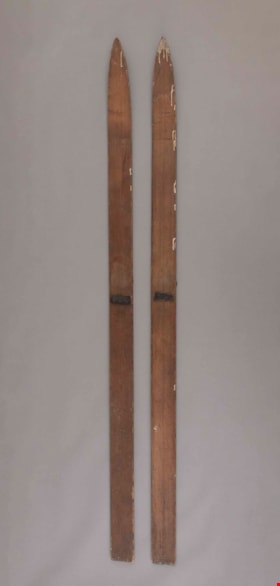
![Oral history interview with Albert Parker - May 9, 1988 - Track 6, [between 1925 and 1930] (interview content), interviewed May 9 1988 thumbnail](/media/hpo/_Data/_BVM_Images/2018/2018_0041_0174_001.jpg?width=280)
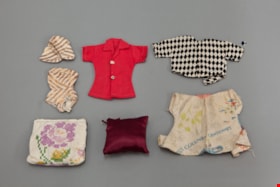
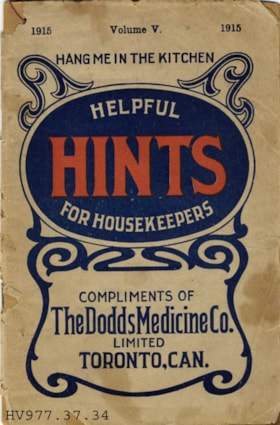
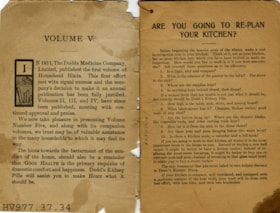
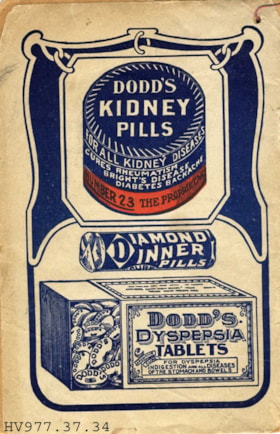
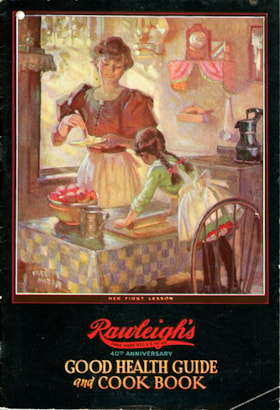
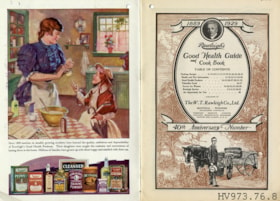
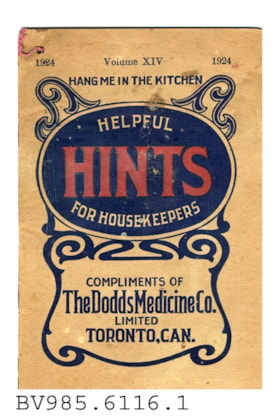
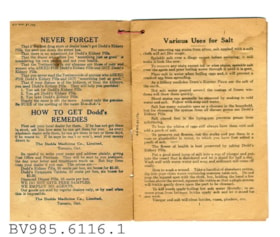
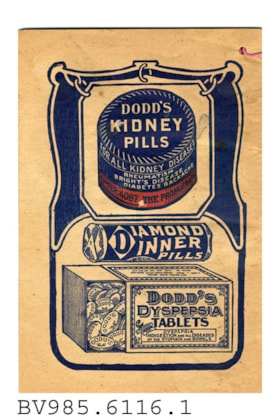
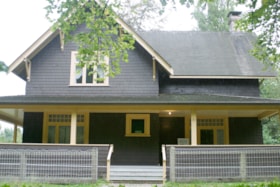
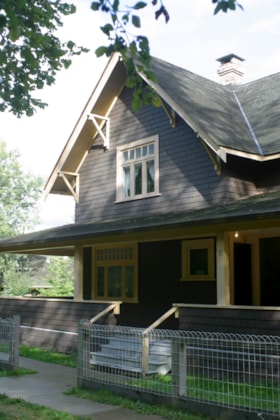
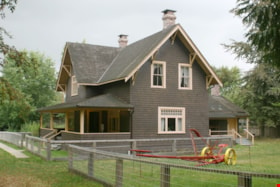
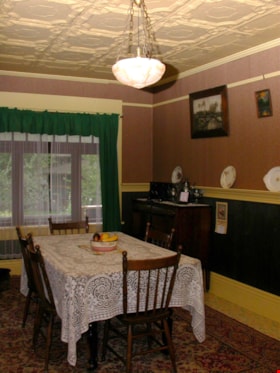
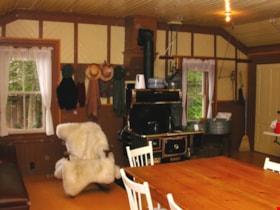
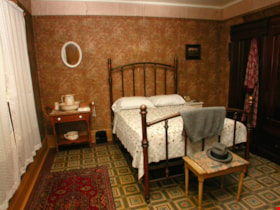
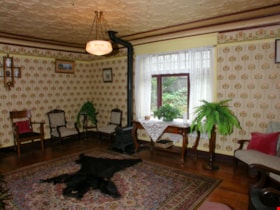
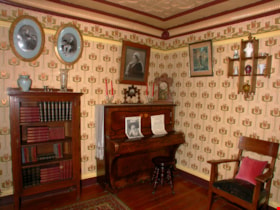
![Elsie Brown-John (bottom, far right) with her class at Kitchener Street School, [1936]. Item no. 549-001. thumbnail](/media/hpo/_Data/_Archives_Images/_Unrestricted/540/549-001.jpg?width=280)
![Interview with Elsie Hughes May 1, 1989 - Track 4, [1925] (interview content), interviewed May 1, 1989 thumbnail](/media/hpo/_Data/_BVM_Images/2019/2019_0008_0010_001.jpg?width=280)
